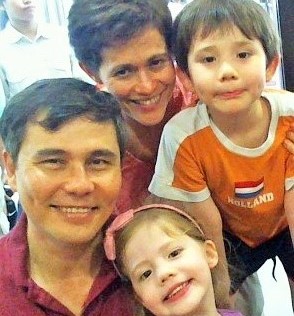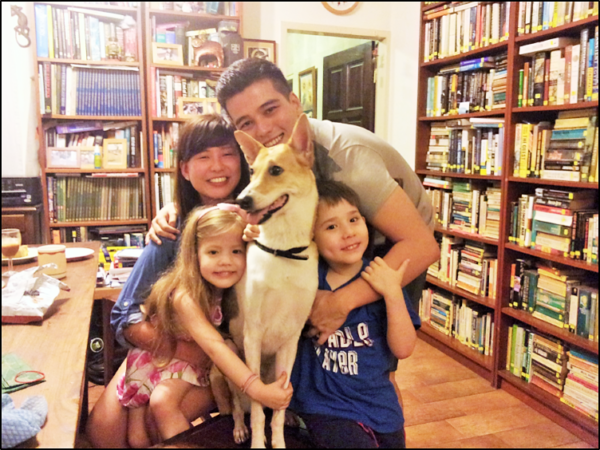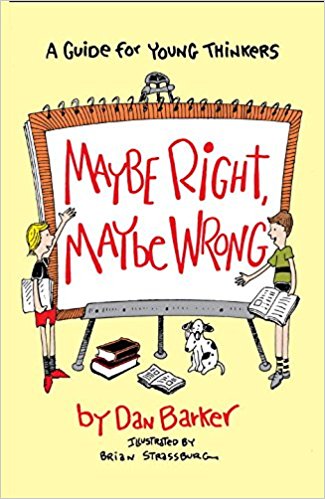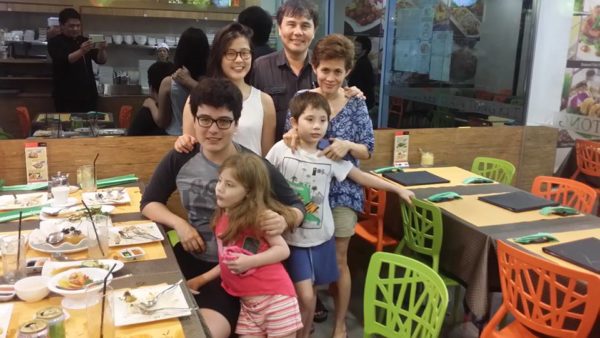This is an abridged version of a speech given by HumanistSG founder Paul Tobin (left, with his wife and two youngest children) at an interfaith dialogue on March 21, 2015, organised by NTU student group PATH, where he talked about teaching his children about moral dilemmas.
Imagine you are in charge of train traffic. A train is moving swiftly towards five hikers crossing the tracks. If you divert the train from the first track, the train will switch to another track where there is only one hiker. What would you do? Let the train move on and kill five, or change the train’s direction and kill just one?
Or imagine, you are a surgeon. Your job is to save five patients dying from various organ failures. A healthy person comes in to donate blood. One of your nurses suggests to you that you harvest his organs and save the five patients, sacrificing the blood donor in the process. What would you do?
These scenarios have been discussed rhetorically around the world. For the train track scenario, about 90 percent of respondents said they would save the five hikers at the expense of the lone hiker. Conversely, in the surgery scenario, most people think it is wrong to kill one person and harvest his organs to save five people.
These are terrible choices to make. In fact, the majority of those who answered were not able to articulate why they made the choices they made for the two scenarios. The fact that most people, regardless of culture, make the same choices for the two scenarios, suggests that some parts of our moral intuition are innate and subconscious. It is very hard to use religious principles (or even philosophical principles such as the “Double effect”) to justify the decisions made.
My journey with dilemmas
As an atheist and a humanist, one of the most common questions I received is how can I, as someone with no belief in gods, can come to a moral judgement and convince someone to act morally without supernatural sanctions.
I was born in Penang and in 1984, I moved to Singapore to pursue my engineering education at the National University of Singapore. I was born to a Roman Catholic family. My father was an Irish Catholic while my mother is a convert to Catholicism from her school days in a convent school. My given names, Paul and Nicholas, were named after Pope Paul VI and the convent (St Nicholas) that my mother attended.
Photo below: Paul at NUS, 4th row, 4th from left.
I was already a very liberal believer by the time I enrolled in NUS. It was obvious to me that the picture of the cosmos discovered by science cannot be reconciled with a literalist reading of the Bible. I was a Catholic, so that view did not bring me any problems. What kept me within the fold, so to speak, is the belief that the only viable source of morality is religion.
Concomitant with my belief in the religious roots of morality (a “deontologist” ethic) was an amorphous belief in the consequence aspect of morality, that morality will always lead to better consequences for all. It was a given in my mind that they can be no contradiction between these two views. God commands what is good. Even if good doesn’t look or feel good, it will be good in the long run for everyone.
My beliefs changed while I was in NUS. There was a pivotal event that shook that belief to its very core. I was attending one of the ‘rights to life’ talk organised by the Catholic students society there at NUS. During the talk, consisting of videos of doctors performing abortions and experts describing the horrible abortion methods used, a fellow Catholic member sitting next to me asked me this question: “Hey, do you know that the Church teaches that if a woman gets pregnant as a result of rape, she is not allowed to have an abortion?”
That was one of those “whoa, wait a minute…” moment of my life. Surely, that cannot be true. Wouldn’t it be cruel to command that? Yet, after discussions with some Catholic priests and a few other friends, that seems to be the case. I was locked in the horns of a dilemma. Is this really a command of the Church (and consequently of God’s)?
My girlfriend at that time, who is now my wife, goes to the Catholic church with me despite being a non-Catholic. She introduced me to the book “Why I am Not a Christian” by Bertrand Russell. That book helped decouple morality from religion. It also started my journey of reading about the history and philosophy of religion and ethics.
In a sense, I am who I am today because of a moral dilemma that confronted me as a student in university.
Teaching my children about dilemmas
This picture is proof of my patriotism. I increased the national fertility rate of 1.2 by having 4.0 kids!
Their names are (from oldest to the youngest) Pat, Sean, Liam and Lizzie. When I had my first two children, Pat and Sean, as a young father I wanted to make an impact on their lives. More importantly, I wanted to impart my values and critical thinking on them.
When it comes to morality, how does one do it? How could one distill philosophy of ethics to seven-year-olds? Having the capacity for morality is insufficient. I have already learnt from my own experience that if morality is presented simply as commands to be obeyed, it leads to an ethical paralysis.
These were some books that helped me:
Some of these were recent purchases, such as the “Creation Stories” and “Parenting Beyond Belief”. I like the former. By presenting various accounts of creation told by various cultures, the child could see how these were attempts by various peoples to understand the world around them before the advent of science. The latter is also good because it offers advice and opinions from academics, authors and parents.
The other books were meant to be read by children themselves. I bought them primarily to help my daughter think about issues.
I want to point out one particular book that I found useful with Pat. That’s “Maybe Right, Maybe Wrong” by Dan Barker. Barker was an ex-evangelical preacher and songwriter who had “lost” his religion and became an atheist. The book, written for children seven years or older, presents ethical lessons through realistic moral situations faced by a preteen named Andrea.
Explaining the difference between commands and principles, we are told that Andrea has been taught what principles are ‘good’, such as ‘one should not hurt others, or allow others to be in pain if one can help it.’ However, it is sometimes difficult to make a decision because, in certain situations, good principles can conflict with each other.
One day Andrea’s cat, Fluffy, was hit by a car. She rushed Fluffy to the vet, only to be told that the cat will probably only live for another day and that there’s nothing else that could be done. In the meantime, Fluffy was in a lot of pain. The vet said she could put Fluffy to sleep immediately and end her suffering, but she needs Andrea to make the decision.
This is a dilemma with two conflicting principles. The first principle is that one should not kill living things and the second principle is that one should not hurt a living thing. In this case, Andrea cannot have both. Ending the hurt also means ending the life of Fluffy. Here is one dilemma where even if one chooses the “right” or “moral” decision, it is not a “happy one”. It is the “least bad.”
In other words, morality is not about following absolute commands, but about making decisions when our principles conflict with one another. This book has been particularly helpful to me in educating my kids about morality.
Today. Pat has graduated, Sean is reading Law in the UK while Liam and Lizzie are just beginning their struggles in the Singapore school system. Apart from my personal life, being a humanist compels me to do, all I can, to make the world a better place. I believe that humanists, with their ethics grounded in our biology, reason and compassion, have much to add to the social discourse and the common good in Singapore.
With ten like-minded humanists, I started the Humanist Society (Singapore) in 2010. We are doing good not just for non-believers, but for the society as a whole. The journey, so far, has been a blast!










